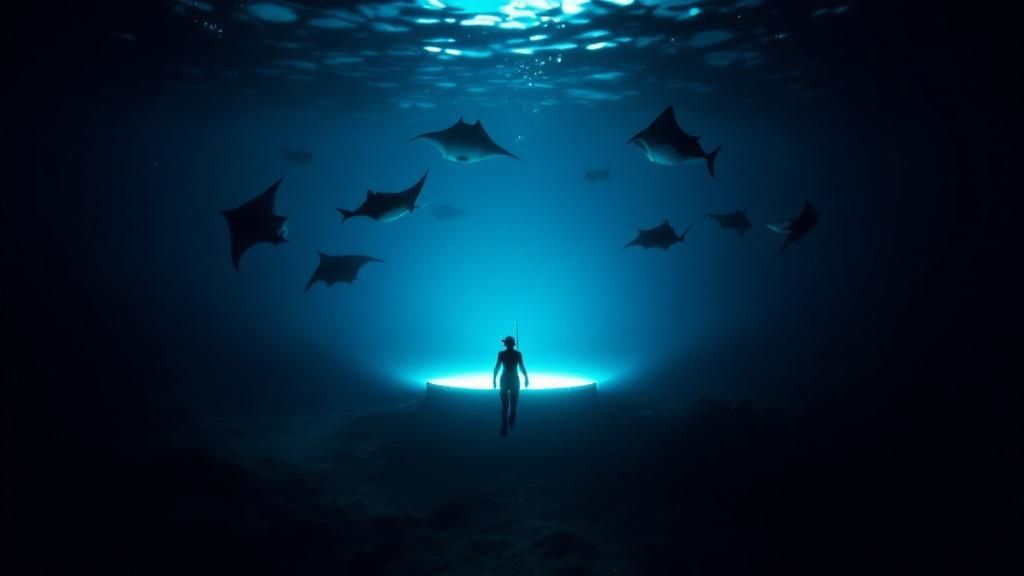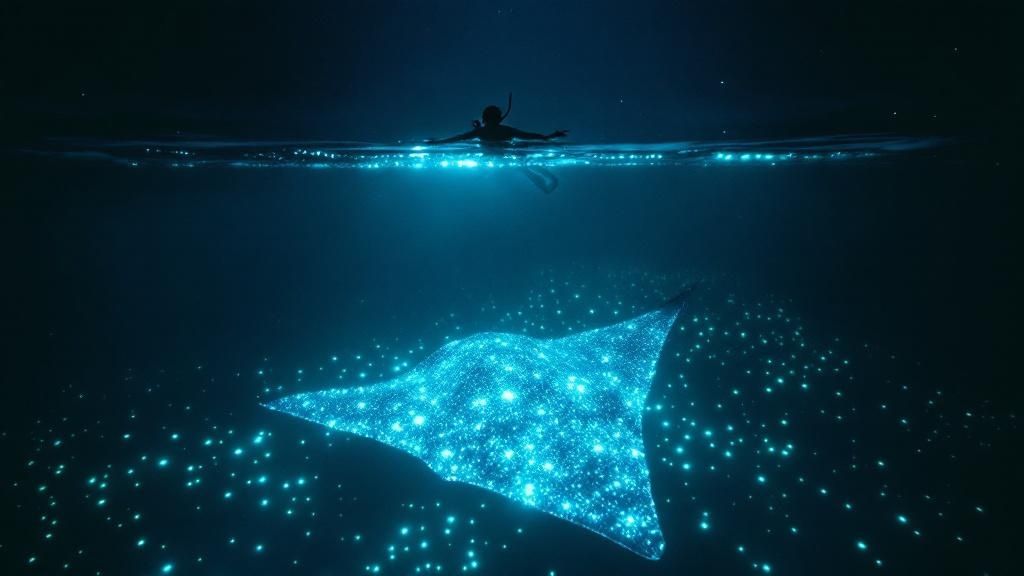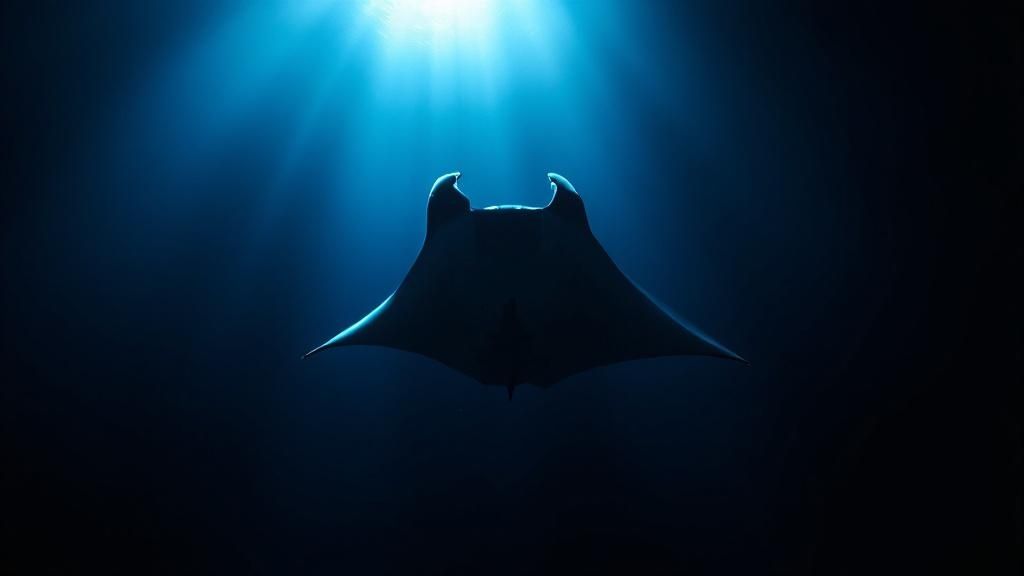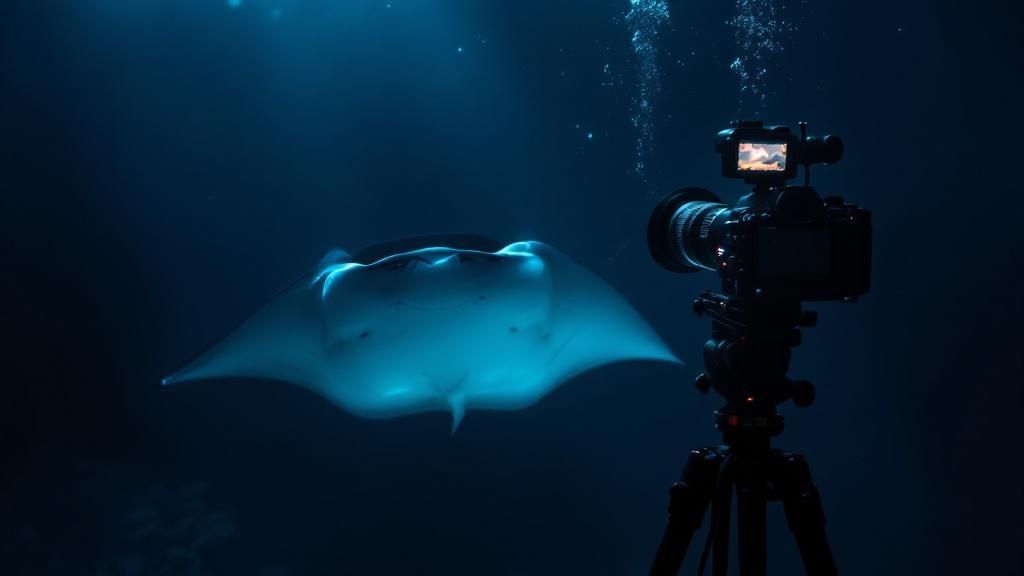Manta Ray Night Snorkel Kona Guide | Experience the Magic

If you're looking for one of the most magical wildlife encounters on the planet, you've found it. The manta ray night snorkel in Kona is an absolute must-do on the Big Island, and we're here to show you exactly why this is the world's best spot for this bucket-list adventure. It’s an experience that people consistently call Hawaii's #1 wildlife encounter for a reason.
Your Unforgettable Kona Manta Ray Snorkel Adventure
Right off the bat, it's crucial to understand that your guide makes all the difference for an incredible—and safe—experience. Kona Snorkel Trips is the top rated & most reviewed snorkel company in Hawaii, and you don't have to take our word for it; the glowing reviews from our guests say it all.
This guide will walk you through everything you need to know to get ready for one of the most mesmerizing evenings of your life. Just picture it: you're floating effortlessly in the warm Pacific right after sunset. Below you, powerful lights cut through the dark water, creating what looks like a brightly lit stage just for you.
The Underwater Ballet
Then, the stars of the show make their entrance. Majestic manta rays, with wingspans that can stretch over 12 feet, glide, swoop, and perform graceful barrel rolls just inches from your face. They're drawn in to feed on the microscopic plankton that flock to the light, creating a surreal and beautiful ballet you just can't find anywhere else.
This is so much more than just watching wildlife from a distance. You're right there, sharing a moment with these gentle giants in their own world. People often describe the feeling as peaceful, deeply moving, and for some, even spiritual.
The feeling of watching a massive fish the shape of a stealth bomber coming into vision is impossible to describe. It’s a profound moment that stays with you long after you've left the water.
This is the heart of the Kona manta ray night snorkel—a safe, respectful encounter that has more than earned its world-famous reputation. You can dive deeper into what makes this trip so special by checking out our overview of the unforgettable magic of the Kona manta ray snorkel.
Ready for the adventure of a lifetime? Kona Snorkel Trips is run by expert guides who put your safety and the well-being of the mantas first. You can book your Manta Ray Snorkel Tour right now and grab your spot for this incredible underwater performance.
Why Kona Is the World’s Manta Ray Capital

So, what makes Kona, Hawaii, the undisputed global hotspot for seeing manta rays? It’s not just a lucky coincidence. It's a perfect storm of geography, biology, and even a little human history that created the ultimate stage for the manta ray night snorkel Kona experience. The conditions here are so reliable that Kona has built an entire worldwide reputation around this one magical encounter.
The secret ingredient? Food. Manta rays are filter feeders, and their main dish is plankton, tiny microscopic organisms. The Kona coast’s unique underwater landscape, carved out by ancient volcanic activity, just happens to be the perfect environment for plankton to gather in huge numbers, right in the same spots, night after night.
This special environment, combined with gentle ocean currents, concentrates the plankton into sheltered bays. The mantas are smart and they’re creatures of habit—they’ve learned that these specific spots are a dependable, all-you-can-eat buffet that’s open every single night. That's why we get to snorkel with them all year round.
The Two Premier Manta Viewing Locations
While you might get lucky and spot a manta anywhere along the coast, the real nightly spectacle happens at two world-famous sites. When you head out with a tour operator like the crew at Kona Snorkel Trips, they'll take you to one of these reliable locations.
-
Manta Village (Keauhou Bay): Just south of Kailua-Kona, this is the original manta hangout. It’s tucked into a sheltered bay that’s often super calm, making it a fantastic choice for families or anyone who might be a bit nervous about being in the ocean after dark. Its gentle conditions and consistent sightings have made it a favorite for decades.
-
Manta Heaven (near the airport): North of town, near the Kona airport, is a spot we affectionately call Manta Heaven. The conditions here can be a little more variable, but this location is famous for attracting massive groups of mantas. On a good night, the sheer number of rays gliding through the water can be absolutely staggering.
Both sites offer an incredible chance to see these gentle giants. Your guide is an expert and will pick the best location based on the ocean conditions for that specific evening, giving you the best shot at an amazing show.
The consistency is what truly sets Kona apart. It’s not about if you'll see mantas, but how many. This reliability turns a hopeful wish into a near-certainty, making it a true bucket-list adventure.
Why Sighting Rates Are So High
This whole incredible nightly event actually started by accident decades ago when a coastal hotel aimed bright lights into the water. These lights attracted plankton, and the mantas, never ones to miss an easy meal, quickly followed. Today, tour operators replicate this effect with powerful, eco-friendly underwater lights—we’re basically just ringing the dinner bell for the local manta population.
The success of this method is unreal. Kona is known all over the world for its manta ray night snorkel, bringing in around 80,000 people every year to see the show. This popularity is fueled by mind-blowing success rates for manta sightings, which consistently hover between 80% and 90% every single night. You can discover more about the statistics behind Kona's manta encounters and see for yourself why it's the number one spot on the planet.
This incredibly high probability is what cements Kona’s reputation. It’s one of the only places on Earth where you can book a wildlife tour with such high confidence of having a genuinely breathtaking experience.
When you understand the science and history behind the spectacle, you can appreciate just how special the manta ray night snorkel Kona truly is. It's a natural wonder, supported by responsible tourism, that creates a memory you'll never, ever forget.
Meet the Gentle Giants of Kona

The real stars of your manta ray night snorkel Kona adventure aren't just fish; they’re a well-known community of gentle giants who call this coastline home. We're talking about Kona's resident reef manta rays (Mobula alfredi), the second-largest manta species on the planet. Getting to know them, even a little, turns a fun activity into a truly personal encounter.
These creatures are just magnificent. The average wingspan is around 12 feet, but some of Kona’s regulars are even wider. Just try to imagine something the size of a small car gliding weightlessly through the water, sometimes just inches away from you. That’s the kind of magic waiting for you out here.
And despite their massive size, they are completely harmless. Manta rays have no teeth, no stingers, and no barbs. Their calm, curious nature is one of the most incredible things about them, making this a peaceful and safe experience for everyone, even if you're a bit nervous about getting in the water at night.
A Community of Individuals
What makes swimming with mantas in Kona so unique is that we're dealing with a well-studied population. Researchers and veteran guides, like our team at Kona Snorkel Trips, have been watching these same mantas for decades. We can actually identify individual rays by the one-of-a-kind pattern of black spots on their white bellies.
Think of it like a human fingerprint—no two are the same. This has allowed the local research community to build an incredible database, giving each manta a name and tracking its life story. You aren’t just swimming with random animals; you might be meeting a local celebrity.
Scientists estimate there are over 450 individual manta rays that frequent the Kona coast, a real testament to how special this ecosystem is. The action usually happens in fairly shallow water, around 30-40 feet, which is perfect for snorkelers to get an amazing view from the surface. On a great night, it’s not unheard of to see groups of up to 36 mantas feeding all at once! You can learn more about Kona's thriving manta population and the science that makes these encounters possible.
Meet the Local Celebrities
Over the years, some mantas have become famous for their personalities and reliable appearances. Your guide will likely be on the lookout for a few of these well-known individuals:
- Lefty: An absolute icon, easily recognized by his damaged left cephalic fin. He's often one of the first to show up to the "campfire" of lights.
- Big Bertha: One of the largest and oldest mantas in the area, she’s a true matriarch of the Kona population.
- Amanda Ray: A beautiful and graceful regular whose name is a clever play on words.
Knowing you might be swimming with a specific, named animal with a known history adds such a cool layer to the whole experience. It feels less like you're just observing wildlife and more like you've been invited into their world for a little while.
By the time you get out of the water, you'll see these creatures as more than just majestic animals—you'll see them as the individuals they are. The manta ray night snorkel Kona is an underwater ballet, and thanks to years of local research, you might just get to know the dancers by name.
How To Choose The Best Time For Your Manta Snorkel

Timing your manta ray night snorkel in Kona can take an incredible trip and make it absolutely legendary. The best part? Kona’s manta ray population sticks around all year, so there’s honestly never a bad time to go.
Still, knowing the subtle differences between seasons helps you pick the perfect night for your adventure. It all comes down to the mantas’ favorite food: plankton. The more plankton in the water, the more mantas show up for the all-you-can-eat buffet we create with our lights. Think of it like a popular food truck festival—some nights are just buzzing with more energy and action than others.
Peak Season vs. Off-Peak Season
The months from April through October are generally considered the prime time for manta encounters. During this period, the ocean is warmer, the seas are calmer, and conditions are just right for huge blooms of plankton. This combo often leads to bigger groups of mantas showing up to the feeding sites. You can get even more insight on how seasons affect manta behavior before you book.
So, what’s the trade-off? It’s usually a classic case of ideal conditions versus crowd sizes.
-
Peak Season (April – October): This is when you get the most comfortable conditions. The water is warmer (often in the high 70s to low 80s), and the ocean is typically flatter. For anyone worried about getting chilly or seasick, summer is your best bet. The higher plankton levels can sometimes mean seeing a truly massive number of mantas.
-
Off-Peak Season (November – March): While the water is a bit cooler, the big advantage here is fewer crowds. With fewer visitors on the island, tours can feel a bit more personal. Plus, you get a massive bonus: it’s humpback whale season! It’s not uncommon to see whales breaching on your way to the manta site, which is a mind-blowing two-for-one experience. And don't worry, even in the "off-season," the manta sightings are still incredibly reliable.
The bottom line is this: the best time to book your manta ray night snorkel in Kona is whenever you're here. Summer might offer postcard-perfect conditions, but the year-round consistency means you’re almost guaranteed a spectacular show any night you go.
Manta Ray Snorkel Seasonality in Kona
To make it even simpler, here's a quick breakdown of what you can expect throughout the year. This should help you plan your trip with a top-rated crew like us at Kona Snorkel Trips.
| Season | Months | Water Conditions | Sighting Probability | Typical Crowd Level |
|---|---|---|---|---|
| Peak Season | April – October | Warmer (78-82°F) & Calmer Seas | Very High | Higher |
| Off-Peak Season | November – March | Cooler (74-77°F) & Variable Seas | High | Lower |
No matter when you decide to come, you're in for a treat. The key is to go with an experienced operator who knows how to read the ocean and find the action.
Does The Moon Phase Matter?
For those of us who really like to geek out on the details, even the moon and tides can play a small part. The moon’s gravitational pull affects the tides, which in turn can influence where the plankton gathers.
During certain lunar phases, that pull can bring plankton closer to the surface at night. This creates a more concentrated buffet for the mantas, potentially making the feeding frenzy right below you even more intense. It’s a subtle factor, but it’s a fascinating part of the whole ecological puzzle that makes this experience so special.
With this knowledge, you can confidently book the manta ray trip that fits you best. We'll be ready for you!
What to Expect on Your Manta Ray Snorkel Tour
So, you're curious about how the manta ray night snorkel Kona experience actually plays out from start to finish? I get it. Knowing the flow of the trip can turn any pre-tour jitters into pure excitement. Let's walk through the whole adventure, from the moment you step on the boat to that jaw-dropping first glimpse of a manta.
Your evening kicks off at the harbor, where you'll link up with the crew from a top-notch outfit like Kona Snorkel Trips. After a friendly check-in, you'll set off on a stunning boat ride along the Kona coast. These trips are almost always timed perfectly to catch a world-class Hawaiian sunset, which paints the sky in incredible colors as you cruise to the snorkel site.
On the way, your guides will run through a detailed safety briefing. They’ll cover everything from how to properly use your snorkel gear to the golden rules of respectful wildlife encounters. This is the perfect time to ask any questions you have and get comfortable with the game plan.
Gearing Up for the Magic
Once the boat is anchored at one of the prime spots like Manta Village or Manta Heaven, it's go-time. The crew will get you sorted with all the gear you need: a high-quality mask, snorkel, and fins. You'll also get a wetsuit, which is key. It doesn't just keep you warm in the night water; it makes you extra buoyant, so floating is effortless.
The real genius of this operation is the custom-built, floating light board. Picture a big, sturdy raft with powerful, eco-friendly lights pointing straight down into the ocean. You and the other snorkelers simply hold onto this board while you're in the water.
Think of the light board as a giant underwater 'campfire.' Its bright glow attracts swarms of microscopic plankton, which is the mantas' favorite meal. Where the plankton go, the gentle giants are sure to follow.
The Main Event: An Underwater Ballet
With everyone holding onto the light board, you'll slide into the surprisingly warm, dark water. Those first few moments are pure anticipation. As your eyes adjust, you'll see the light beams cutting through the darkness, illuminating the clouds of plankton and small fish darting about.
And then… it happens. A huge, dark shape emerges from the blackness, gliding without effort toward the light. Seeing a manta ray for the first time is just a moment of pure, unfiltered awe. They swoop and perform graceful barrel rolls right beneath you, sometimes just inches away, as they feast on the plankton. Their movements are a mesmerizing mix of power and grace.
You’ll spend about 30-45 minutes in the water, just floating and watching this unbelievable show unfold. The mantas are completely unfazed by your presence since you're just passively observing from the surface. For a more in-depth look at how this all works, check out our detailed guide to manta ray night snorkeling.
After the show of a lifetime, you'll climb back onto the boat, absolutely buzzing. The crew usually has warm drinks and snacks waiting for the cozy ride back to the harbor. It’s the perfect time to trade stories and relive the incredible encounter you just had. The whole experience is designed from top to bottom for safety, comfort, and maximum wonder.
How to Snorkel with Mantas Safely and Responsibly

A truly unforgettable wildlife encounter is one that’s safe for both you and the animals. There’s a reason the manta ray night snorkel in Kona is a world-class experience—it’s built on a foundation of respect and responsible practices.
Your most important decision is choosing a certified, eco-conscious tour operator. Companies like us, who adhere to strict standards, are committed to protecting these gentle giants. These guidelines ensure the encounters are sustainable, allowing this magical experience to thrive for generations to come.
The Golden Rule: Passive Observation
The absolute core principle of a responsible manta encounter is passive observation. It's a simple but powerful idea that guides everything we do out there. Just think of yourself as a guest in their underwater dining room—you're there to watch the show, not become part of it.
This boils down to a few critical rules:
- No Touching: Manta rays have a delicate, protective mucus layer on their skin, like a shield against infection. Touching them can rub this layer off, leaving them dangerously vulnerable to disease.
- No Chasing: Never chase, grab, or try to ride a manta ray. This stresses them out and interrupts their natural feeding patterns.
- Stay at the Surface: As a snorkeler, your job is to float peacefully on the surface, holding onto the light board. This keeps the water column below open and clear, giving the mantas plenty of room to maneuver and do their thing safely.
Following these guidelines isn't just about rules; it’s about respect. When you practice passive observation, you're actively helping to protect the health and well-being of Kona’s beloved manta ray population.
Essential Snorkeling Safety Tips
Of course, beyond respecting the mantas, your personal safety is our top priority. Your guides are absolute experts at making sure you have a secure and comfortable trip, but it always helps to know what to expect.
Listen carefully to the safety briefing your guide gives you and always stay near them and the light board. Make sure to use your gear as instructed—the wetsuit we provide gives you extra buoyancy and warmth, which makes it much easier to float and relax. For a deeper dive on what the experience is like, check out our guide on snorkeling with manta rays in Kona.
By following these simple safety measures and choosing a reputable operator, you can just relax and soak in a peaceful, incredibly safe, and completely respectful adventure.
Your Manta Ray Snorkel Questions, Answered
Even after getting the whole rundown on the magic of the manta ray night snorkel Kona experience, it's totally normal to have some last-minute questions buzzing in your head. Let's tackle the most common ones we hear from our guests so you can show up for your tour feeling confident and ready to go.
Do I Need to Be a Strong Swimmer?
Not at all. I get this question all the time, and the answer always surprises people. This is one of the most accessible ocean adventures in Hawaii, period.
The whole time you're in the water, you’ll be holding onto a big, sturdy, custom-made light board that floats on the surface. That board provides all the support you need. Plus, we'll get you suited up in a wetsuit, which is naturally very buoyant, and offer other flotation if needed. You can just relax and float without any effort. Your only job is to watch the incredible manta ballet happening right below you.
Is the Manta Ray Night Snorkel Safe?
Yes, this is an extremely safe tour, especially when you go out with a certified and professional operator like Kona Snorkel Trips. Manta rays are true gentle giants. They don't have teeth, stingers, or barbs—they are filter feeders and are completely harmless to people.
The real safety focus is just following your guide's instructions, staying with the group, and keeping your hands on the light board. We create a secure and controlled environment so everyone can just enjoy the show.
The biggest safety concern is actually for the mantas themselves. That's why the "no touching" rule is so critical. Touching a manta can damage the protective slime coating on their skin, which leaves them open to dangerous infections. Responsible tourism keeps both you and these amazing animals safe.
What Happens if No Manta Rays Show Up?
It's a valid question! While Kona is one of the most reliable places on Earth to see manta rays—with success rates often topping 90%—they are wild animals. Their appearance can never be a 100% guarantee.
Good, reputable companies know this and usually offer a "manta guarantee." If for some reason the mantas decide not to come out and play on your tour, you can typically rebook and try again on another night for free, based on availability. This is a great reason to book your tour for earlier in your vacation—it gives you a backup plan, just in case.
What Should I Bring on the Tour?
We provide all the important gear: your mask, snorkel, fins, and a wetsuit. All you really need to bring are your personal items to make the trip more comfortable.
Here’s a quick checklist:
- A towel and a change of warm, dry clothes for the ride back.
- A reusable water bottle.
- Any personal medications you might need.
- If you're prone to seasickness, it's a good idea to take something before the boat leaves the dock.
Ready to book this unforgettable adventure? Go with Kona Snorkel Trips, Hawaii's top-rated and most-reviewed snorkel company, for an experience you'll cherish forever. Check out the Manta Ray Snorkel Tour page for more details.
